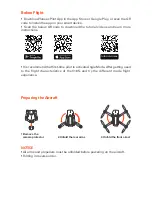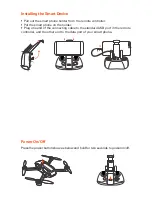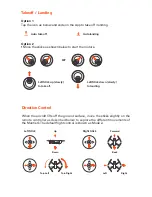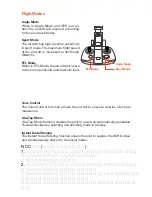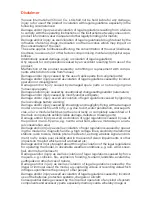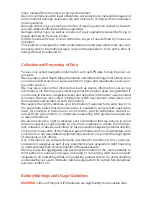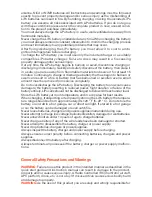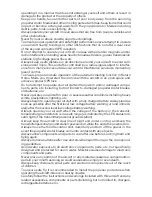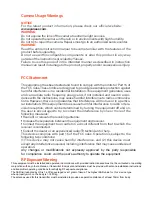
alkaline, NiCd or NiMH batteries. All instructions and warnings must be followed
exactly to prevent property damage and/or serious injury as the mishandling of
LiPo batteries can result in fire. By handling, charging or using the included LiPo
battery you assume all risks associated with LiPo batteries. If you do not agree
with these conditions please return the complete product in new, unused condi-
tion to the place of purchase immediately.
You must always charge the LiPo battery in a safe, well-ventilated area away from
flammable materials.
Never charge the LiPo battery unattended at any time. When charging the battery
you must always remain in constant observation to monitor the charging process
and react immediately to any potential problems that may occur.
After flying/discharging the LiPo battery you must allow it to cool to ambi-
ent/room temperature before recharging.
To charge the LiPo battery you must use only the included charger or a suitably
compatible LiPo battery charger. Failure to do so may result in a fire causing
property damage and/or serious injury.
If at any time the LiPo battery begins to balloon or swell, discontinue charging or
discharging immediately. Quickly and safely disconnect the battery, then place it
in a safe, open area away from flammable materials to observe it for at least 15
minutes. Continuing to charge or discharge a battery that has begun to balloon or
swell can result in a fire. A battery that has ballooned or swollen even a small
amount must be removed from service completely.
Do not over-discharge the LiPo battery. Discharging the battery too low can cause
damage to the battery resulting in reduced power, flight duration or failure of the
battery entirely. LiPo cells should not be discharged to below 3.0V each under load.
Store the LiPo battery at room temperature and in a dry area for best results.
When charging, transporting or temporarily storing the LiPo battery the tempera-
ture range should be from approximately 40–120 ° F (5–49 ° C). Do not store the
battery or aircraft in a hot garage, car or direct sunlight. If stored in a hot garage
or car the battery can be damaged or even catch fire.
Never leave batteries, chargers and power supplies unattended during use.
Never attempt to charge low voltage, ballooned/swollen, damaged or wet batteries.
Never allow children under 14 years of age to charge batteries.
Never charge a battery if any of the wire leads have been damaged or shorted.
Never attempt to disassemble the battery, charger or power supply.
Never drop batteries, chargers or power supplies.
Always inspect the battery, charger and power supply before charging.
Always ensure correct polarity before connecting batteries, chargers and power
supplies.
Always disconnect the battery after charging.
Always terminate all processes if the battery, charger or power supply malfunc-
tions.
General Safety Precautions and Warnings
WARNING:
Failure to use this product in the intended manner as described in the
quick start guide and instruction manual can result in damage to the product,
property and/or cause serious injury. A Radio Controlled (RC) multirotor aircraft,
APV platform, drone, etc. is not a toy! If misused it can cause serious bodily harm
and damage to property.
WARNING:
As the user of this product you are solely and wholly responsible for
operating it in a manner that does not endanger yourself and others or result in
damage to the product or the property of others.
Keep your hands, face and other parts of your body away from the spinning
propellers/rotor blades and other moving parts at all times. Keep items that could
impact or become entangled away from the propellers/rotor blades including
debris, parts, tools, loose clothing, etc.
Always operate your aircraft in open areas that are free from people, vehicles and
other obstructions.
Never fly near or above crowds, airports or buildings.
To ensure proper operation and safe flight performance never attempt to operate
your aircraft nearby buildings or other obstructions that do not offer a clear view
of the sky and can restrict GPS reception.
Do not attempt to operate your aircraft in areas with potential magnetic and/or
radio interference including areas nearby broadcast towers, power transmission
stations, high voltage power lines, etc.
Always keep a safe distance in all directions around your aircraft to avoid colli-
sions and/or injury. This aircraft is controlled by a radio signal subject to interfer-
ence from many sources outside your control. Interference can cause momentary
loss of control.
To ensure proper and safe operation of the automatic landing function in Return
Home Mode you must start the motors with the aircraft in an open space and
achieve a proper GPS lock.
Do not attempt to operate your aircraft with any worn and/or damaged compo-
nents, parts, etc. including, but not limited to, damaged propellers/rotor blades,
old batteries, etc.
Never operate your aircraft in poor or severe weather conditions including heavy
winds, precipitation, lightning, etc.
Always begin to operate your aircraft with a fully charged battery. Always land as
soon as possible after the first level low voltage battery warning or land immedi-
ately after the second level low voltage battery warning.
Always operate your aircraft when the voltage of the battery in the transmit-
ter/personal ground station is in a safe range (as indicated by the LED status indi-
cator light of the transmitter/personal ground station).
Always keep the aircraft in clear line of sight and under control, and keep the
transmitter/personal ground station powered on while the aircraft is powered on.
Always move the throttle control stick down fully and turn off the power in the
event the propellers/rotor blades come into contact with any objects.
Always allow components and parts to cool after use before touching them and
flying again.
Always remove batteries after use and store/transport them per the correspond-
ing guidelines.
Avoid water exposure to all electronic components, parts, etc. not specifically
designed and protected for use in water. Moisture causes damage to electronic
components and parts.
Never place any portion of the aircraft or any related accessories, components or
parts in your mouth as doing so could cause serious injury or even death.
Always keep chemicals, small parts and electronic components out of the reach
of children.
To ensure safe fly, it is recommended to install the propeller protectors when
operating the aircraft indoors or nearby crowds.
Carefully follow the instructions and warnings included with this aircraft and any
related accessories, components or parts (including, but not limited to, chargers,
rechargeable batteries, etc.).
Camera Usage Warnings
NOTICE
For the latest product information, please check our official website:
www.yuneec.com.
WARNING
Do not expose the lens of the camera to extreme light sources.
Do not operate the camera in the rain or in environments with high humidity.
Do not try to repair the camera. Repairs must go to an authorized service center.
WARNING
Read the entire instruction manual to become familiar with the features of the
product before operating.
Do not use with incompatible components or alter this product in any way
outside of the instructions provided by Yuneec.
Failure to use this product in the intended manner as described in instruction
manual can result in damage to the product, property and/or cause serious injury.
FCC Statement
This equipment has been tested and found to comply with the limits for Part 15 of
the FCC rules. These limits are designed to provide reasonable protection against
harmful interference in a residential installation. This equipment generates, uses
and can radiate radio frequency energy and, if not installed and used in accor-
dance with the instructions, may cause harmful interference to radio communica-
tions. However, there is no guarantee that interference will not occur in a particu-
lar installation. If this equipment does cause harmful interference to radio or tele-
vision reception, which can be determined by turning the equipment off and on,
the user is encouraged to try to correct the interference by one or more of the
following measures:
• Reorient or relocate the receiving antenna.
• Increase the separation between the equipment and receiver.
• Connect the equipment to an outlet on a circuit different from that to which the
receiver is connected.
• Consult the dealer or an experienced radio/TV technician for help.
This device complies with part 15 of the FCC rules. Operation is subject to the
following two conditions:
(1) This device may not cause harmful interference, and (2) this device must
accept any interference received, including interference that may cause undesired
operation.
RF Exposure Warning
This equipment must be installed and operated in accordance with provided
instructions and the antenna(s) used for this transmitter must be installed to
provide a separation distance of at least 20 cm from all persons and must not be
co-located or operating in conjunction with any other antenna or transmitter.
End-users and installers must be provided with antenna installation instructions
and transmitter operating conditions for satisfying RF exposure compliance.
IC Radiation Exposure Statement for Canada
This device complies with Industry Canada licence-exempt RSS standard(s).
Operation is subject to the following two conditions: (1) this device may not
cause interference, and (2) this device must accept any interference, including
interference that may cause undesired operation of the device. Le présent appar-
eil est conforme aux CNR d'Industrie Canada applicables aux appareils radio
exempts de licence. L'exploitation est autorisée aux deux conditions suivantes :
(1) l'appareil ne doit pas produire de brouillage, et (2) l'utilisateur de l'appareil doit
accepter tout brouillage radioélectrique subi, même si le brouillage est suscepti-
ble d'en compromettre le fonctionnement.
This equipment complies with IC RSS-102 radiation exposure limit set forth for an
uncontrolled environment. Cet équipement respecte les limites d'exposition aux
rayonnements IC définies pour un environnement non contrôlé.
NCC Warning Statement
本產品符合低功率電波輻射性電機管理辦法 第十二條 ~ 第十四條等條文規定:
* 經型式認證合格之低功率射頻電機,非經許可,公司、商號或使用者均不得擅
自變更頻率、加大功率或變更原設計之特性及功能。
* 低功率射頻電機之使用不得影響飛航安全及干擾合法通信;經發現有干擾現象
時,應立即停用,並改善至無干擾時方得繼續使用。
前項合法通信,指依電信法規定作業之無線電通信。低功率射頻電機須忍受合法
通信或工業、科學及醫療用電波輻射性電機設備之干擾。
CE Warning Statement
This device meets the EU requirements on the limitation of the general public to
electromagnetic fields by way of health protection.
EU Operation Frequency (The Maximum Transmitted Power)
Mantis Q Remote Controller:
5G: 5470–5725MHz (27dBm)
Mantis Q:
5G: 5470–5725MHz (27dBm)
EU Compliance Statement
Hereby, Yuneec International (China) Co., Ltd. declares that this device is in com-
pliance with the essential requirements and other relevant provisions of the RED
Directive 2014/53/EU. The full text of the EU Declaration of Conformity is available
at the following internet address: http://yuneec/de-downloads
Please visit the address above and enter into corresponding product page.
Radiation Exposure Statement:
The exposure standard for wireless transmitter employs a unit of measurement known as
the Specific Absorption Rate, or SAR. The SAR limit set by the IC is 1.6W/kg.
The highest SAR value for the EUT as reported to the IC when worn on the body, as described in
this user guide, is 0.769 W/kg.
La norme d'exposition pour l'émetteur sans fil utilise une unité de mesure connue sous le
nom de taux d'absorption spécifique, ou SAR. La limite SAR fixée par l'IC est de 1,6 W / kg.
La valeur SAR la plus élevée pour l'EUT signalée à l'IC lorsqu'elle est portée sur le corps, comme
décrit dans ce guide de l'utilisateur, est de 0.769 W / kg.
This equipment complies with IC radiation exposure limits set forth for an uncontrolled environment. This equipment should be
installed and operated with minimum distance 10mm between the radiator & your body.
Déclaration d’exposition aux radiations:
Cet équipement est conforme aux limites d’exposition aux rayonnements IC établies pour un environnement non
contrôlé. Cet équipement doit être installé et utilisé avec un minimum de 10mm de distance entre la source de
rayonnement et votre corps.


